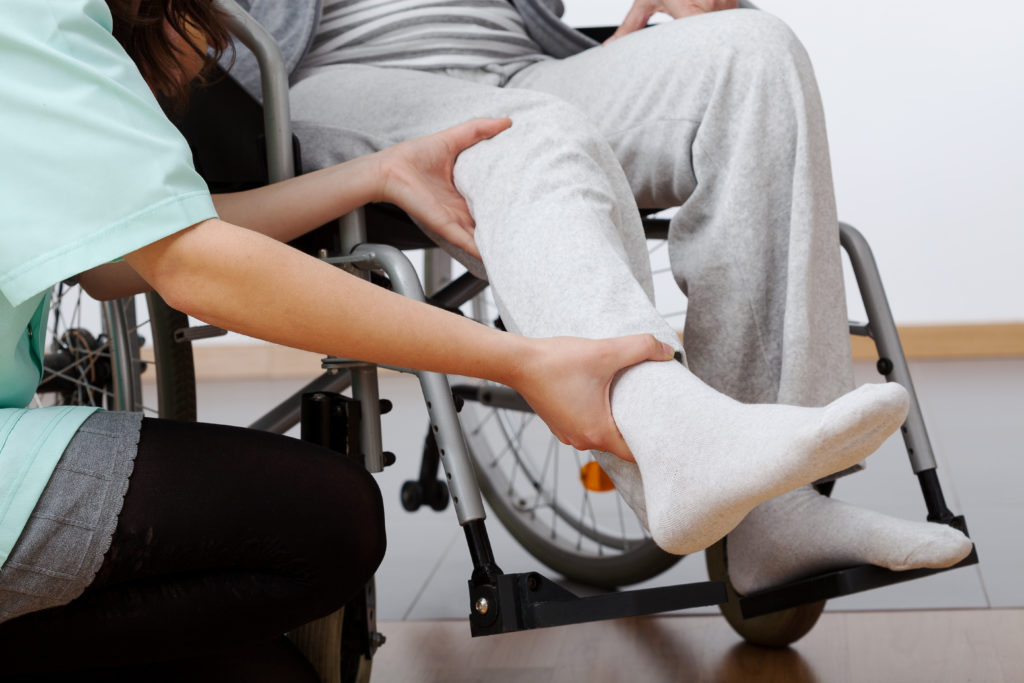San Diego Spinal Cord Injury Attorney
- 550+ Google 5-Star Reviews
- $1 Billion won over 15 years
- Won’t settle for low offers, not afraid to fight for max value

Get a Free Case Evaluation
No fees until we win!
All San Diego Case Types

Personal Injury

Brain Injury

Car Accident

Slip & Fall

Truck Accident

Wrongful Death
Spinal Cord Injury Lawyers
When you suffer a spinal cord injury in an accident, you are suddenly forced into an incredibly uncertain situation. You may be unable to walk or continue with your career in the same capacity. Your life may not ever look the same. While you may be able to recover from your spinal cord injury, your future may remain uncertain for a long time.
During this time of uncertainty, you will undoubtedly suffer substantial financial losses. If your injury was the result of another person’s negligent, reckless, or intentional acts, you may file an injury claim to recover these losses. To do this, you will need the services of an experienced and skilled San Diego spinal cord injury attorney. You need Gomez Trial Attorneys.
Our San Diego Spinal Cord Injury Lawyers On Your Side
Why Choose Us?
At Gomez Trial Attorneys, our San Diego spinal cord injury lawyers know what it takes to win these complex cases. We know that no two spinal cord injuries are ever the same. That is why we give personalized attention to each one of our clients from the start. We work with you and your medical team to determine how your injuries will ultimately affect your life and your future. We use this information to help you get maximum compensation after a spinal cord injury accident.
We know that your time is better spent on your rehabilitation and treatment. Let us take the legal burdens off of you. Our attorneys can negotiate with insurance companies, investigate the accident, and build a case to help you collect the money you deserve.
For decades, the personal injury lawyers at Gomez Trial Attorneys have helped injured accident victims and their families throughout San Diego. Some of our most notable spinal cord injury cases include:
- $10.8 million for an accident victim who suffered cervical fractures and brain injury
- $2.1 million for an accident victim who suffered a neck injury
- $1.65 million for an accident victim who suffered a neck injury
- $1.5 million for an accident victim who suffered a spinal injury
- $800,000 for an accident victim who suffered a neck injury
While past success does not guarantee future results, you can rest easier knowing that you have a team of experienced and dedicated personal injury lawyers on your side. You also have a law firm with the resources to tackle these tough cases from the start.
We have offices all over California, including one in San Diego at 655 West Broadway, Suite 1700. Our office is within walking distance of Waterfront Park and the USS Midway Museum in San Diego. You can take the Sycuan Green Line trolley to the Santa Fe Depot station to get to our office easily. If traveling is difficult, don’t worry, we understand. That is why we are happy to meet with you virtually, in your home, or even in the hospital.
You deserve to explore all your legal options. If you suffered a spinal cord injury as a result of someone else’s wrongful conduct, please give us a call at (619) 237-3490. We offer FREE Initial consultations to all injured accident victims.
How Much is My San Diego Spinal Cord Injury Lawsuit Worth?
Collecting Compensation After a Spinal Cord Injury
When you suffer a spinal cord injury, you need someone on your side that can help you get the money you need. Since no two spinal cord injuries are ever quite the same, it is difficult to determine how much your spinal cord injury lawsuit is worth without a complete investigation into your accident.
However, when you choose Gomez Trial Attorneys, our attorneys will sit down with you and discuss your accident and your injuries. We will work closely with your medical team and experts to determine how much you will need to move forward in the future after your accident. Your final settlement or award should compensate you for all the damages you suffered.
Those damages include both economic and non-economic losses, such as:
- Past and future medical expenses
- Ongoing therapy costs
- Equipment costs
- Costs for new construction in the home if a person is confined to a wheelchair
- Costs for a specially-outfitted vehicle if a person is paralyzed
- Costs for ongoing medical care
- Lost income
- Pain and suffering
- Loss of companionship
How Much Will My San Diego Spinal Cord Injury Cost?
Spinal injuries are costly. From initial trauma treatment to long-term care and rehabilitation, you are looking at weeks or even months in a hospital. If you now have to use a wheelchair or require living assistance, it can get even more expensive. In addition, there is also the potential of losing your job due to your injuries, a new disability, or the rehabilitation that often follows. Following a spinal cord injury, your life may change significantly, and often permanently. Expenses can range into millions of dollars.
In terms of real costs, estimates indicate that the costs of a spinal cord injury are significant. Paraplegics will face lifetime costs of nearly $2.3 million, not including losses for pain and suffering and loss of companionship. Quadriplegics will face lifetime costs of over $4,7 million. Both of these estimates assume that a person is injured at the age of 25 and otherwise healthy at the time.
What to Do After a San Diego Spinal Cord Injury Accident?
One of the best things you can do to protect yourself and your future after a serious accident in San Diego is to hire an attorney. At Gomez Trial Attorneys, our San Diego spinal cord injury lawyers know that many spinal injuries are avoidable and often result from another person’s negligence.
Insurance companies excel at low-balling claimants, which is why you should retain our law firm to help maximize your compensation for your injuries, recovery, and pain and suffering. Our San Diego spinal cord injury attorneys specialize in dealing with insurance companies that are more focused on their profits than the well-being of victims.
The road to recovery will be long, painful, and expensive. You need all the help you can get. While we focus on the investigation and negotiations, you can help your injury case by taking the following steps:
- Attend all rehabilitation and therapy sessions
- Fill all prescription medications promptly
- Keep all receipts of OTC medications and any other bills you pay
- Follow your doctor’s treatment plan
- Keep a journal of your recovery and treatment, including your pain and suffering
Understanding San Diego Spinal Cord Injuries
 According to the National Spinal Cord Injury Statistical Center, or the NSCISC, the following statistics relate to spinal cord injuries in the United States:
According to the National Spinal Cord Injury Statistical Center, or the NSCISC, the following statistics relate to spinal cord injuries in the United States:
- Approximately 17,000 people suffer some sort of spinal cord injury every year.
- More than 250,000 people in the United States are living with spinal cord injuries.
- The average age of a person who suffers a spinal cord injury is 42 years old.
- Males account for approximately 80 percent of new spinal cord injury cases.
- Approximately 30 percent of people who suffer a spinal cord injury return to the hospital within one year of the injury.
These are significant statistics, and despite much in the way of medical advancement, many spinal cord injuries are permanent.
What is a Spinal Cord Injury?
The spinal cord is a long, continuous group of nerve cells that serve as a superhighway for transmitting signals to and from the brain. Due to the specialized nature of these cells, however, they are very poor at regenerating if they are damaged. The spinal cord is protected by spinal fluid, tissue, and an articulated system of bones from the base of your brain to your tailbone, which you might know as your spine. Since you need to be able to move and function, the spine has a range of motion, but these joints don’t move as much as an elbow or a hip.
The spine can only do so much to protect from a spinal cord injury. If massive amounts of force are directed in the right place, the spine cannot protect the spinal cord. Kinking, bruising, or severing the spinal cord disrupts the flow of information from the brain to the rest of the body. The nerves cannot transmit their signals, and because the spinal cord is such a complex neural network, it does not heal well. If a nerve is severed, it may result in permanent injury.
Long-term Effects of a Spinal Cord Injury
Like any injury that involves the brain and nerve tissue, spinal injuries are complex. In broader terms, spinal injuries often mean loss of sensation and function of affected extremities. The loss of feeling and function in one’s arms, legs, and trunk is common.
In some cases, only partial paralysis occurs. A spinal injury might leave you with partial function and feeling in one arm or leg, and the loss of use in the other. Severe spinal injuries affect more than arms and legs. Since the brain sends signals to and from your organs and systems, a spinal injury can result in difficulty breathing or disruption of other involuntary functions.
Depending on the severity of the damage and the location of the injury, it may take a while for the long-term effects of a spinal injury to become fully known. Some cases result in temporary paralysis, while others leave a person with complete and total paralysis. Some survivors of neck injuries suffer from chronic pain or phantom pain, where extremities that are otherwise healed (or missing in some cases) continue to flare up with excruciating pain.
Unfortunately, a spinal injury often results in a diminished quality of life, either through permanent disability, or a need to rely on medical devices such as feeding tubes, respirators, and full-time care for daily survival.
Whether it is a less severe injury or one that affects a person’s quality of life permanently, spinal cord injury victims will also face mental trauma. Post-traumatic stress disorder (PTSD), nightmares, depression, anxiety, and other forms of mental trauma are common following a spinal cord injury. Some of these traumas contribute to self-harm, stress-related diseases such as heart disease or diabetes, and even suicide.
The pain and suffering, ensuing depression, and post-traumatic stress associated with a spinal cord injury can also take their toll on victims. Medication, therapy, and even permanent cognitive difficulty might make it impossible to maintain employment. At the very least, you will emerge with a limited range of movement, intensive rehabilitation, and probably some form of permanent disability. Some people face chronic pain as well as the trappings of a pain management program, which can often lead to opioid addiction or dependency on painkillers.
Does a Spinal Cord Injury Shorten Your Life?
As with any severe trauma, you face the risk of succumbing to your injuries if you’ve suffered a severe spinal cord injury. Injuries may also result in an extended vegetative state. A spinal cord injury may affect involuntary functions, such as breathing, pumping blood, and even digesting food, and thus lead to death. Even the use of ventilators, feeding tubes, and long-term care may result in a significantly diminished length or quality of life.
Types of Spinal Cord Injuries in San Diego
 There are two types of spinal cord injuries:
There are two types of spinal cord injuries:
- Incomplete spinal cord injuries. Incomplete spinal cord injuries involve those injuries where the spinal cord is partially severed.
- Complete spinal cord injuries. Complete spinal cord injuries are those where the spinal cord is completely severed. Complete spinal cord injuries result in a loss of movement and sensation below the site of the injury.
There are different categories of incomplete spinal cord injuries, including:
- Anterior Cord Syndrome – Anterior cord syndrome occurs when the primary blood supply to the anterior portion of the spinal cord is interrupted. This leads to a loss of movement and sensation.
- Central Cord Syndrome – This is the most common form of cervical spinal cord injury. It involves damage to the grey matter of the spinal cord and leads to loss of motion and sensation in the hands and arms.
- Brown-Séquard Syndrome – This is a condition that results when trauma is inflicted on one half of the spinal cord, either the left or the right side. It also leads to a loss of movement and sensation on the side where the trauma occurred and a loss of temperature and pain sensitivity on the other.
Causes of San Diego Spinal Cord Injuries
The most common way to injure your spine is through direct force. The spine can only move so far and still protect your spinal cord. Direct and general force bends and breaks the spine past its limits of flexibility. Our bodies are often at the mercy of the laws of physics. Though we have evolved to survive the forces of nature, sometimes technology and activities push those limits to the point of breaking them.
According to the Mayo Clinic, the following are the leading causes of spinal cord injuries in the United States:
- Acceleration/deceleration injuries. Common when a body in motion stops suddenly and then returns to motion suddenly.
- Impacts and collisions. This occurs when something heavy or traveling with a lot of force strikes the spine, which is typical of violence-related injuries, car collisions, work-related injuries, and sports injuries.
- Motor vehicle accidents. Cars, trucks, motorcycles, boats, and airplanes travel at great speeds. During a motor vehicle crash, the results are often widespread, causing lots of damage. Due to the severity and complexity of a vehicle accident, spinal cord injuries may be severe and varied. Distracted driving and drunk driving both increase the risk of suffering serious spinal cord injuries in crashes.
- Swimming. Diving into shallow water is dangerous because of the force and the angle at which your neck and back may strike an object, such as the bottom of a swimming pool. A spinal injury in the ocean, a pool, or a lake may also result in a loss of consciousness and thus the possibility of drowning.
- Sports injuries. Whether it is football, hockey, soccer, rock climbing, cycling, or martial arts, any time you push your body to the limit, your spine is at risk.
- Assaults. Being attacked physically with either a blunt weapon, knife, or gunshot can cause extreme damage to your spinal cord. Even physical assaults without weapons can direct enough force to injure the spine. Being shaken, kicked, struck, or grappled can result in permanent injury.
- Slip and fall. Your body picks up a lot of force and momentum during a fall. A slip and fall can result in a spinal injury, especially if the neck comes out of alignment. It doesn’t take much force to break a back or a neck, despite the importance of both to the rest of the body.
Treatment for a San Diego Spinal Cord Injury is Costly
Medical treatment is necessary for the treatment and recovery of any spinal injury. Surgery, antibiotics, and medication to control swelling are important in dealing with the initial injury. Rehabilitation and physical therapy are also used to try to regain or strengthen lost motor skills. In many ways, physical therapy is like teaching the body how to work all over again. It is extremely painful, frustrating, and a long, mentally exhausting process.
Some treatments of spinal injuries include medically-induced comas, long-term splinting and traction, multiple surgical procedures, and extended hospital stays. In some cases, spinal injury patients never return home. For those who do not succumb to their injuries, full-time critical care and hospice facilities are their only option. If a person’s family is unequipped to care for him or her at home, a critical care facility might be the best option moving forward.
Some patients may also qualify for stem cell regeneration treatment. However, this technology is still in its early stages, and though some anecdotal reports of its benefits are floating around in the media, it is not yet a common treatment method. As technologies improve, this may change. Right now, however, the stem cell regeneration process is experimental. Unfortunately, there currently is no cure or sure-fire treatment to reverse the damage caused by a spinal cord injury.
All of these treatments are costly. Any settlement or award you receive should consider the varied treatments you may need to endure, and the costs associated with these treatments. After all, you may need treatment both now – and into the future. At the Gomez Trial Attorneys, our San Diego spinal cord injury lawyers can help you get the money you need to pay for the treatment you require after a serious accident.
Spinal Cord Injury Statistics
According to the National Spinal Cord Injury Statistical Center, or the NSCISC, the following statistics relate to spinal cord injuries in the United States:
- Approximately 17,000 people suffer some sort of spinal cord injury every year.
- More than 250,000 people in the United States are living with a spinal cord injury.
- The average age of a person who suffers a spinal cord injury is 42 years old.
- Males account for approximately 80 percent of new spinal cord injury cases.
- Approximately 30 percent of people who suffer a spinal cord injury return to the hospital within one year of the injury.
These are significant statistics, and despite much in the way of medical advancement many spinal cord injuries are permanent.
Spinal Cord Injury FAQ
It only takes a few seconds, a singular moment to change the course of the rest of your life. If you had to make a list of the top five most frightening injuries, a spinal cord injury would likely fall near the top of the list. If you are researching spinal injuries and trying to determine what you or a loved one might be facing for the rest of your life, here is a list of frequently asked questions (with answers) that might help you decide on your course of action.
Why is the spinal cord important?
To know about spinal injuries, you need to know a little bit about how the central nervous system works. The brain directs the actions and processes of all your body’s systems. It is linked to every function in some way, from the touch you feel on your skin, to how many beats per minute your heart pumps blood. Specialized cells called neurons work to transmit and carry information. Because they work on an electrochemical impulse, communication between these cells is nearly instantaneous, which is why stubbing your toe on a chair results in immediate pain.
The spinal cord is a long, continuous group of nerve cells that serve as a superhighway of transmitting signals to and from the brain. Due to the specialized nature of these cells, however, they are very poor at regenerating if they are damaged. The spinal cord is protected by spinal fluid, tissue, and an articulated system of bones from the base of your brain all the way to your tailbone, which you might know as your spine. Since you need to be able to move and function, the spine has a range of motion, but these joints don’t move as much as an elbow or a hip.
What is a spinal injury?
The spine can only do so much to protect from a spinal cord injury. If massive amounts of force are directed in the right place, the spine can do little to protect the spinal cord. Kinking, bruising, or severing the spinal cord disrupts the flow of information from the brain to the rest of the body. The nerves cannot transmit their signals, and because the spinal cord is such a complex neural network, it does not heal as well as a stubbed toe or a cut finger. If a nerve is severed, it may result in permanent injury.
What areas of the body does a spinal cord injury affect?
Depending on the area of the injury, your body responds in different ways. Typically, the lower the injury on the spine, the less severe the impact on the rest of the body. Upper spinal injuries, such as cervical injuries (the area of the neck), may result in permanent loss of sensation or movement in the majority of the body. Lower injuries may result in partial paralysis. Even tailbone injuries can damage reproductive and sexual health.
What are some different types of injury?
Breaking your neck and back are the most common types of spinal cord injury, but there are other ways to damage your spinal cord, as well. Fevers or severe infections, such as meningitis, have a similar effect on the spine. Also, compression without breaking the spinal column may cause swelling inside the protective sheath of the spinal cord. This buildup of blood and spinal fluid winds up crushing the tissue inside, and unless doctors can quickly reduce pressure with surgery or medication, the nerves may suffer permanent damage.
What are some common results of a spinal injury?
Spinal cord injuries are complex, just as any injury that involves the brain and nerve tissue. In broader terms, spinal injuries often mean loss of sensation in and the function of your extremities. Loss of feeling and function in arms, legs, and trunk is common. In some cases, only partial paralysis occurs. A spinal injury might leave you with partial function and feeling in one arm or leg, and the loss of use in the other. Severe spinal injuries affect more than arms and legs. Since the brain sends signals to and from your organs and systems, a spinal injury can result in difficulty breathing or other involuntary functions.
What are the different ways in which injuries may happen?
The most common way to injure your spine is through direct force. The spine can only move so far and still protect your spinal cord. Direct and general force bends and breaks the spine past its limits of flexibility. Our bodies are often at the mercy of the laws of physics, and though we have evolved to survive the forces of nature, sometimes technology and activities push those limits to the point of breaking.
Some of the most common causes of spinal injuries include:
- Acceleration/deceleration injuries: Common when a body in motion stops suddenly and then returns to motion suddenly, and common with a variety of different injuries in which speed and force is an issue.
- Impacts and collisions: Something heavy or traveling with a lot of force strikes the spine; typical of violence-related injuries, car collisions, work-related injuries, and sports injuries.
- Vehicle accidents: Cars, trucks, motorcycles, boats, and airplanes travel at great speeds, and when they wreck, the results are often widespread and may inflict lots of damage. The body can only withstand so much, and the breaking point is, unfortunately, your spine in many cases. Due to the severity and complexity of a vehicle accident, injuries may be severe and varied.
- Swimming: Diving into shallow water is dangerous because of the force and the angle in which your neck and back may strike an object or the bottom of a pool of water. The surrounding water offers a lot of resistance, which your body cannot withstand the way it would on dry land, and so the force is unable to be displaced through your body’s flexibility. A spinal injury in a pool may also result in a loss of consciousness and thus the possibility of drowning. Shutting off oxygen to the brain quickly results in brain damage beyond the extent of the trauma alone.
- Sports injuries: Whether it is football, hockey, soccer, rock climbing, cycling, or martial arts, any time you push your body to the limit, your spine is at risk. Studies have shown that sports-related impacts over time can cause brain damage in the form of concussions and other injuries.
- Assaults: Being attacked physically with either a blunt weapon, knife, or gunshot can cause extreme damage to your spinal cord. Even physical assaults without weapons direct enough force to the spine in direct impacts, twisting, and even asphyxiation to damage your nerve tissue. Being shaken, kicked, struck, or grappled can result in permanent injury.
- Slip and fall: Your body picks up a lot of force and momentum as it suddenly goes from a standing position to hitting the ground. A slip and fall can result in a spinal injury, especially if the neck comes out of alignment. It doesn’t take much force to break a back or a neck, despite the importance of both to the rest of the body.
What are the lasting effects of a spinal injury?
Depending on the severity of the damage and the location of the injury, there isn’t much else to do other than wait for the body to heal before you can fully determine the extent of the trauma and its lasting effects. Some cases result in temporary paralysis, while others leave a person with quadriplegia, and learning to continue your life without the ability to move or feel anything from the neck down is challenging. Some survivors of neck injuries suffer from chronic pain or phantom pain, where extremities that are otherwise healed (or missing in some cases) continue to flare up with excruciating pain.
A spinal injury often results in a diminished quality of life, either through permanent disability, or a need to rely on medical devices, such as feeding tubes, respirators, and full-time care in daily survival. Whether it is a less severe injury or one that affects a person’s quality of life permanently, spinal cord injury victims will also face mental trauma. Post-traumatic stress disorder (PTSD), nightmares, depression, anxiety, and other factors are common following a spinal cord injury. Some of these traumas contribute to self-harm, stress-related diseases, such as heart disease or diabetes, and even suicide.
What is the treatment for a spinal cord injury?
Medical treatment is necessary for the treatment and recovery of any spinal injury. Surgery, antibiotics, and medication to control swelling are important in dealing with the initial injury. Rehabilitation and physical therapy are also used to try to regain or strengthen motor skills that have been lost. In many ways, physical therapy is like teaching the body how to work all over again. It is extremely painful, frustrating, and a long, mentally exhausting process.
Some treatments of spinal injuries include medically-induced comas, long-term splinting and traction, multiple surgical procedures, and extended hospital stays. In some cases, spinal injury patients never return home. For those who do not succumb to their injuries, full-time critical care and hospice facilities are their only option. If a person’s family is unequipped to care for him or her at home, a critical care facility might be the best option moving forward.
What about stem cell regeneration treatment?
This technology is still in its early stages, and though some anecdotal reports of its benefits are floating around in the media, it is not a common treatment method yet. As technologies improve, this may change, however. Right now, the stem cell regeneration process is experimental. Unfortunately, there currently is no cure or sure-fire treatment to reverse the damage caused by a spinal cord injury.
Are spinal cord injuries fatal?
As with any severe trauma, you face the risk of succumbing to your injuries if you’ve suffered a spinal cord injury. Injuries may result in an extended vegetative state. A spinal cord injury may affect involuntary functions, such as breathing, pumping blood, and even digesting food, and thus lead to death. Even the use of ventilators, feeding tubes, and long-term care may result in a significantly diminished length or quality of life.
How much will a spinal cord injury cost me?
Spinal injuries are costly. From initial trauma treatment to long-term care and rehabilitation, you are looking at many hours, if not days or months, in a hospital. If you now have to use a wheelchair or require living assistance, it can get expensive. In addition, there is also the potential to lose your job due to your injuries, a new disability, or the rehabilitation that often follows. Following a spinal cord injury, your life may change significantly, and often permanently. Expenses can range into millions of dollars.
What are some long-lasting repercussions of the injury?
The pain and suffering, ensuing depression, and post-traumatic stress associated with a spinal cord injury can also take their toll on victims. Medication, therapy, and even permanent cognitive difficulty might make it impossible to maintain employment. At the very least, you will emerge with a limited range of movement, intensive rehabilitation, and probably some form of permanent disability. Some people face chronic pain as well as the trappings of a pain management program, which can often lead to opioid addiction or dependency on painkillers.
What should I do now?
While doctors are fighting to save the life of the person injured, you should hire an attorney. In most cases, spinal injuries are avoidable and often result from another person’s negligence.
Insurance companies excel at low-balling claimants, which is why you should retain an attorney to help maximize your compensation for your injuries, recovery, and pain and suffering. Personal injury attorneys specialize in dealing with insurance companies that are more focused on their profits than the well-being of victims.
The road to recovery will be long, painful, and expensive. You need all the help you can get. Contact us today to set up a consultation and begin the process of seeking compensation for your injuries.
Call Our San Diego Spinal Cord Injury Lawyers at Gomez Trial Attorneys today!
If you or someone you love has suffered a spinal cord injury because of the actions of someone else, you need to make sure that you protect and enforce your legal rights. When you choose the San Diego spinal cord injury lawyers at Gomez Trial Attorneys, you have a law firm that has earned hundreds of millions of dollars in judgments and settlements on your side. Our reputation in the San Diego legal community is invaluable when facing such a difficult situation. Our attorneys offer personalized and compassionate legal guidance and support at every turn. Contact our San Diego injury law firm today to schedule a free initial consultation.
What We Got
$2,800,000
Original Offer
$481,000
Our Process... Easy as 1. 2. 3!
Call Us
We will determine your case and submit
We get to work
You will get regular update from us
Win
Collect your compensation
-
“John helped me find doctors, he referred me to his neurologist, his physical therapist, I mean, anything I needed he was right there, every step of the way. I couldn’t have asked for a better result from all of this, I would absolutely recommend Gomez Trial Attorneys.”
-
“During the time I was working with Gomez Trial Attorneys, they treated me very, very well. 100% of the time, they believed me, and they were very compassionate. They felt sorry for what happened and they understood the therapy process.”
-
“They held my hand the whole time and kept me in the loop every aspect of my case which was very refreshing to me. They helped me get my settlement offer as fast as possible and I was able to keep my farm”
-
“The Gomez experience was the best experience it could be for me really, only positive things to say. They really were there every step if the way. Thanks to Gomez Trial Attorneys my dad is able to support my family as a single father”
-
“He opened the door for me to join his firm to help other brain Injury survivors and I never met another firm who is like this who was so understanding and caring who took the extra step and walked the extra mile with their clients and this is the best”
-
“I am very satisfied with the outcome with Gomez and I would definitely recommend Gomez to anybody, we tell people all the time, Get Gomez! They are really thorough with everything and they make you feel real comfortable.”
-
“Just helped us through, guided us through, I kept notes all those years, we had questions all the time and they would always keep us informed of what was going on. They just unlayered it, layer by layer, I’ve never seen anything like them. Thank God for them.”


